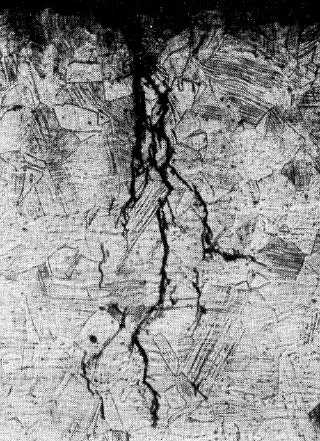T.O. 33B-1-1
2-87
cracks, it is important to know the history or circumstances associated with the occurrence of the stress corrosion
cracking. Depending upon the service of the part, fatigue cracks may be free of contamination and may be easily
detected with penetrant testing or they may be filled with contamination or under such high residual compressive stress
that they are impossible to detect with penetrant. Stress corrosion cracks may have very little or a lot of corrosion
products trapped in the cracks. The amount of corrosion product present significantly affects the detectability of this
type of cracking. As with fatigue cracks, certain types of stress corrosion cracking may not be detectable with penetrant
methods. Extended dwell times may also be required to detect stress corrosion cracking.
Figure 2-34. Micrograph of a Cross-Section through a Stress Corrosion Crack.
2.7.6.2.3.3 Corrosion.
The penetrant inspection method is occasionally used to detect corrosion. Corrosion usually attacks the material at the
grain boundaries faster than at the interior of the grains and forms a network of very fine cracks. In the early stages,
the cracks are visible only under 10X or greater magnification. Penetrant indications of intergranular corrosion appear
as a residual background that can only be resolved under magnification. Developer is not used when evaluating a
penetrant indication using a magnifying glass (see paragraph 2.7.6.3). Penetrant inspection is often used to monitor
the surface for adequacy of corrosion removal by grinding. Caution must be exercised, since the mechanical removal
causes smearing which may obscure indications of remaining corrosion attack (see paragraph 2.3.6.2). In monitoring
corrosion grind-out areas, a developer is not used. Following removal of excess surface penetrant, the area is examined
using a low power magnifying glass (3X to 5X). The examination should be repeated after a minimum 5 minute dwell
in lieu of developer. When the corrosion is no longer detected, the inspection process SHALL be repeated using
nonaqueous developer.


